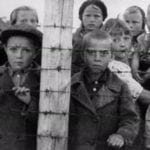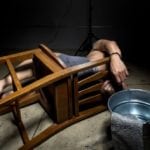 Mysteries
Mysteries  Mysteries
Mysteries  History
History 10 Surprising Stories About the Texas Rangers
 Humans
Humans 10 Philosophers Who Were Driven Mad by Their Own Theories
 Miscellaneous
Miscellaneous 10 Video-Game-Worthy Weapons and Armors from History
 Weird Stuff
Weird Stuff 10 Psychics Who Accurately Predicted Wartime Events
 The Arts
The Arts 10 Pieces of Art Inspired by a Broken Heart
 Health
Health 10 Science Fiction-Sounding New Medical Treatments
 History
History 10 Surprising Facts About the Father of Submarine Warfare
 Space
Space Ten Astonishing New Insights into Alien Worlds
 Weird Stuff
Weird Stuff 10 Bizarre Summer Solstice Rituals Still Practiced Today
 Mysteries
Mysteries Top 10 Haunting Facts About the Ghost Ship MV Alta
 History
History 10 Surprising Stories About the Texas Rangers
 Humans
Humans 10 Philosophers Who Were Driven Mad by Their Own Theories
Who's Behind Listverse?

Jamie Frater
Head Editor
Jamie founded Listverse due to an insatiable desire to share fascinating, obscure, and bizarre facts. He has been a guest speaker on numerous national radio and television stations and is a five time published author.
More About Us Miscellaneous
Miscellaneous 10 Video-Game-Worthy Weapons and Armors from History
 Weird Stuff
Weird Stuff 10 Psychics Who Accurately Predicted Wartime Events
 The Arts
The Arts 10 Pieces of Art Inspired by a Broken Heart
 Health
Health 10 Science Fiction-Sounding New Medical Treatments
 History
History 10 Surprising Facts About the Father of Submarine Warfare
 Space
Space Ten Astonishing New Insights into Alien Worlds
 Weird Stuff
Weird Stuff 10 Bizarre Summer Solstice Rituals Still Practiced Today
10 Horrifying Stories From Communist Prisons And Labor Camps
Following the Bolshevik Revolution in Russia in 1917, the sociopolitical doctrine of communism claimed its first state. Despite a massive military intervention in 1918 which featured soldiers and sailors from the British Empire, the United States, France, Serbia, and Belgium,[1] and despite the Japanese occupation of Siberia and Sakhalin Island that lasted until 1925, the communist government in Moscow managed to survive.
Following World War II, communism spread beyond Russia’s borders to Eastern and Central Europe, Latin America, and East Asia. Although not all communist states were alike, each were totalitarian dictatorships, and almost all of them had in place “reeducation” systems that subjected political prisoners, criminals, and everyday citizens to horrific physical and mental abuse. Some of these penal systems, such as the Soviet Union’s gulags, are well-known in West. Others have been all but forgotten, and in some communist states today, camp horrors still exist.
10 S-21
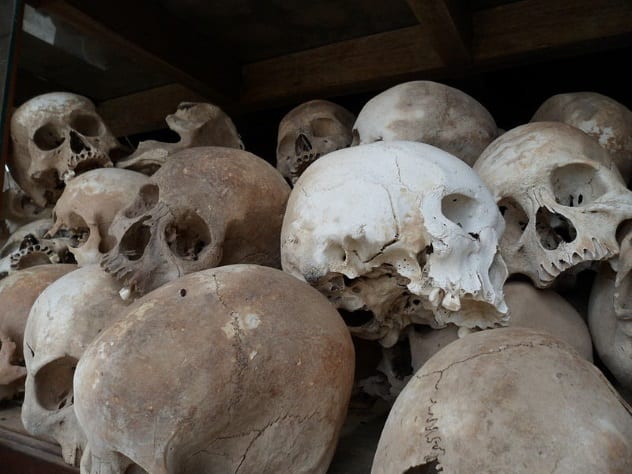
In 1960, Saloth Sar and Nuon Chea, two ethnic Khmers from Cambodia, formed a small cadre of Mao-inspired communists. Officially called the Communist Party of Kampuchea, this group is better known by its French name, Khmer Rouge (“Red Khmers”). Its leader, Saloth Sar, would later rename himself Pol Pot.
From 1960 until 1975, the Khmer Rouge led a guerrilla campaign against the Kingdom of Cambodia, the latter of which had backing from the United States and France. The “Red Khmers” had support from Ho Chi Minh’s communists in Vietnam, but these two groups would later have a serious falling out that would lead to a full-scale Vietnamese invasion of Cambodia in 1979.
Much of this of this falling out was due to the sheer brutality of the Khmer Rouge’s regime. Beginning in 1975, as part of the “Year Zero” policy, two million urban dwellers in Phnom Penh and other cities were forced to toil as agricultural laborers in the countryside. All of this was done in order to turn Cambodia into a rural, egalitarian society. Therefore, the Khmer Rouge banned money, markets, schooling, private property, religion, and other aspects of traditional Khmer culture. In order to force compliance, the Khmer Rouge established reeducation camps throughout the country. The most infamous of these camps was S-21.
Following Vietnam’s invasion, prison guards at S-21, which was located in Phnom Penh, fled the scene. Left behind were thousands of photographs and letters from prisoners. In total, it is believed that some 30,000 prisoners were held at S-21, 12,000 of whom were killed.
Duch, real name Kaing Guek Eav, would later tell an international court all about the type of torture methods used at S-21. These methods included beatings with sticks, electric shock, suffocation via plastic bags, and a crude form of waterboarding that used a towel and water. Electrical wires were also used to whip inmates, while female inmates were singled out for rape and sexual assault.[2] Some former Khmer Rouge members have admitted that although the point of torture was to extract confessions, most of the time, it was done for personal enjoyment.
In total, between 1975 and 1979, Pol Pot’s regime murdered between 1.5 and 2 million Cambodians. Pot himself died in 1998 at the age of 72.
9 Vietnam’s Reeducation Camps
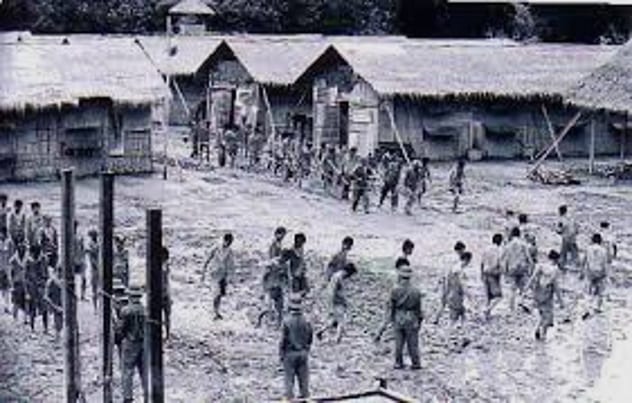
Despite removing the awful and genocidal Khmer Rouge from Cambodia, the communists of Vietnam should not be labeled as great humanitarians. Indeed, following North Vietnam’s successful takeover of South Vietnam in 1975, the communists established brutal reeducation camps throughout the country.
It has been estimated that between one and 2.5 million people entered the camps in 1975 alone under the new government’s promise of a quick “reeducation” in communist dogma. The camps themselves were divided into five different levels. The level one camps were study camps that indoctrinated inmates with Marxist-Leninist thought. These inmates were allowed to go home every night. Level two camps had the same purpose, but inmates could not return home for three to six months. Approximately 700,000 people were forced to attend both level one and level two camps.
The level three camps, or socialist reform camps, contained about 50,000 inmates. Level four and five camps, like the level three camps, were designed to force inmates to work long, hard days under primitive conditions. In these camps were those deemed less susceptible to socialist ideology, including intellectuals, Roman Catholics, teachers, legislators, and judges. Even as late as 1987, some 15,000 of these inmates were still incarcerated.[3]
It is believed that as many as 165,000 Vietnamese people died in these camps between 1975 and 1990. The number might be much higher, however. Also, given that the first reeducation camps were started in North Vietnam in 1961, it is possible that over one million Vietnamese people died in communist-run camps in both North and South Vietnam.
8 The Xinjiang Camps
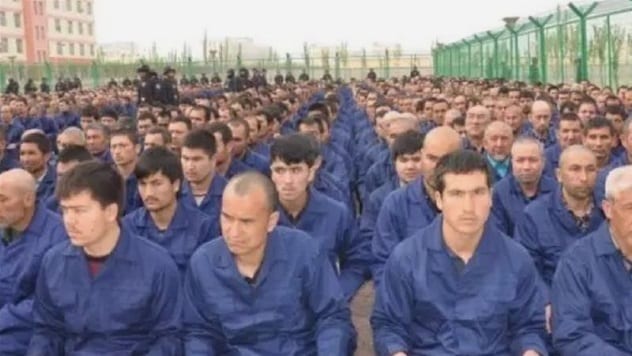
The Xinjiang region of far-western China has been a hotbed of violence for centuries. In 1775, the Qing Empire, an ethnic Manchu dynasty that ruled all of China from Beijing, began the liquidation of the Dzungar people, or ethnic Mongols who lived in Xinjiang, following a rebellion against Qing rule. In total, between 480,000 and 500,000 Dzungars, or 80 percent of their population, were killed by Qing soldiers and their allies. The remaining 20 percent were forced into slavery.
It is another minority people, the Muslim Uyghurs, who are currently facing a government crackdown in Xinjiang. As we speak, roughly one million people are held in internment camps in China. A large portion of these inmates are Uyghurs. It is claimed that ten percent of the entire Uyghur population in China is currently being detained in one of the many reeducation camps in Xinjiang.[4]
The purpose of these camps is to “reeducate” Uyghurs and to get rid of their ethnic and religious identity. Uyghur inmates are forced to speak Mandarin and reportedly must say, “I’m not a Muslim,” on a daily basis. These same punishments are forced on other minority groups, including Hui Muslims, Kazakhs, Uzbeks, Turkmen, and even non-Muslim minorities.
In 2018, Uyghur activists told Radio Free Asia, a US-funded radio station designed to counter communist propaganda in East Asia, that the reeducation camps in Xinjiang are filthy work camps where inmates are forced to praise Xi Jinping daily, sing communist songs, and publicly confess to such “crimes” as attending a mosque or traveling outside of China. One former inmate, an ethnic Kazakh named Kayrat Samarkand, told the American media that he experienced grueling interrogation sessions that lasted for multiple days. Samarkand also stated that he was tortured one day by being forced to wear a metal suit that weighed over 23 kilograms (50 lb).
The Chinese government officially legitimizes this practice by highlighting Islamist terrorism inside of China itself and high Uyghur participation in the Syrian Civil War and in Afghanistan on behalf on groups affiliated with ISIS and Al-Qaeda. (Both accusations are true.)
7 ‘Farewell To The World’
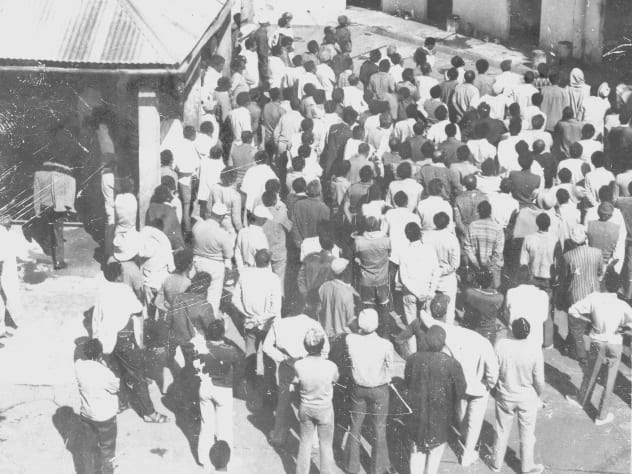
Very few outside of the Ethiopian diaspora have ever heard of the Derg. The Derg, which was officially known as the Provisional Military Government of Socialist Ethiopia, came to power in 1974. It would hold on to power until 1987. In that time, several humanitarian crises rocked the country, including a massive famine, an economic collapse, and military defeats against the armies of Eritrea and the Tigray people. The worst of it all occurred between 1984 and 1986, when two years of drought caused a famine that affected 5.8 million people. This famine was then followed by locust and grasshopper plagues in 1986. Overall, the famines and plagues killed 1.2 million people.
Besides these “natural” disasters (which were really the result of government villagization and oppression), the Derg was responsible for a massive campaign of terrorism known collectively as the Red Terror. The Red Terror, which was announced after the Derg took power in Addis Ababa, saw military troops and communist militiamen invade homes and villages in search of “counterrevolutionaries.” As many as 50,000 people were killed during the Red Terror.[5]
Many of the Red Terror’s victims wound up as inmates at the Alem Bekagn (“Farwell to the World”) prison in Addis Ababa. Already made infamous during the Yekatit 12 massacre, where Ethiopian intellectuals were murdered by Italian fascists, Alem Bekagn saw torture and mass executions under the Derg. In 1990, Argentine forensic experts uncovered several mass graves at Alem Bekagn. One of the worst atrocities at the prison, the Massacre of Sixty, saw Derg officials execute 60 former members of Emperor Haile Selassie’s government. Others executed at the prison included Ethiopian teenagers, suspected anti-communists, and intellectuals. The African Union believes that 10,000 were executed at the prison, while thousands more died due to overcrowding and disease.
6 Lenin’s Gulags

Many Soviet apologists will claim that Vladimir Lenin, the first communist ruler of Bolshevik Russia, was not a genocidal maniac a la Stalin. However, this is false and overlooks how Lenin’s regime expanded the old Tsarist system of Siberian prison camps and turned them into the “gulag archipelago.”
By 1920, there were some 84 work and prison camps in Russia, all of which were designed to “rehabilitate” enemies of the Soviet system. By 1923, the camp system had expanded to over 300. At that point, the total inmate population in Russia stood at a staggering 70,000. As early as 1918, in a letter penned by Leon Trotsky, the Soviet state sought to use the gulags as a way to modernize Russia on the backs of slave labor. In the letter, Trotsky stated that inmates, whom Trotsky calls “vermin,” must experience “thousands of forms and means of practical reckoning by the communes themselves.”[6] In practice, this translated to inmates being worked to death in order to build railroads and factories.
Lenin’s dreaded secret police, the Cheka, also ran their own camps. In 1920, 100,000 Russian citizens were convicted in Cheka courts and sentenced to work camps. The Cheka camps of 1920 were only built to house 40,000 to 60,000 inmates. At these camps and all over camps during Lenin’s regime, unsanitary conditions led to thousands of deaths due to disease, while starvation, overwork, and executions claimed all other lives. Lenin’s gulags were also thoroughly corrupt, with career criminals given freedom in the camps to prey upon their fellow inmates.
5 The Belene Labor Camp
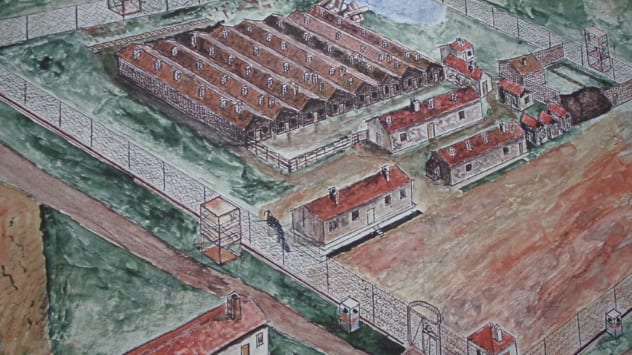
The Belene Labor Camp is often called a “concentration” camp by Western sources. The use of this word, which is most closely associated with the horrors of the Nazi Holocaust, should tell you all you need to know about how awful this Bulgarian prison really was.
Operated off and on from 1949 until 1989, the camp on Belene Island housed thousands of male and female political prisoners. Housed alongside political prisoners were hardened criminals, whom the communist guards encouraged to “terrorize” the political offenders. During the 1950s, hundreds of inmates died from malnutrition and exhaustion because they were forced to cut down trees, harvest vegetables, and do other kinds of manual labor with very little food or water. Those convicted of breaking camp rules were often used for target practice by the guards or sent adrift at sea in order to freeze to death.
The camp was formally closed in 1959, following the anti-Stalinist purges directed by the Soviet Union. However, during the 1970s and 1980s, Bulgarian Muslims and ethnic Turks who opposed the assimilation campaigns run by the communist government were detained on Belene Island and held in squalid conditions for months to years.[7] Such religious persecution was not unique, as earlier during the 1950s, Christian pastors were frequently sent to the camp as “spies.” One of those inmates, Haralan Popov, wrote a book outlining all the ways in which camp guards and wardens tried to convert religious inmates to atheism. Those who resisted were often tortured for days on end.
4 Castro’s Concentration Camps
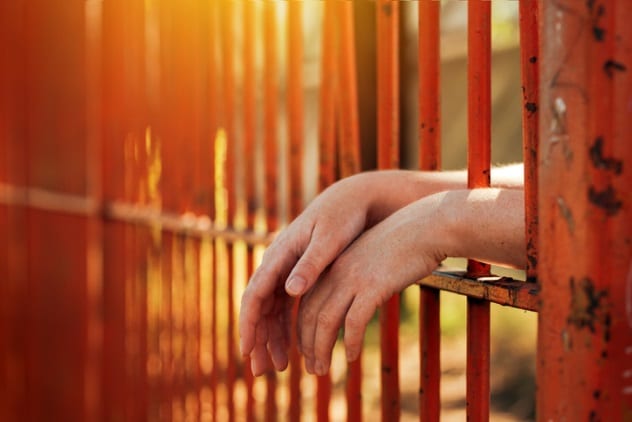
The term “concentration camp” was born on the verdant island of Cuba in the late 19th century. Originally, the term denoted Spanish-run camps that housed supporters of Cuban independence. The United States later used these camps as justification for the Spanish-American War of 1898.
Decades later, Fidel Castro’s communist state reintroduced concentration camps to the Cuban people. Under the unassuming name of Military Units to Help Production (UMAP), Castro’s government began forcing all those suspected of “counterrevolutionary” activity and attitudes to these camps in November 1965. At the UMAP camps, humiliation, torture, and rape were common. So, too, was suicide, as many inmates killed themselves rather than die by starvation or disease.[8]
The purpose of these camps was to “reeducate” Cubans to the wonders of socialism. Religious Christians, rock and roll fans, men with long hair, and those deemed too ideologically close to the United States and the West were forced to perform hard labor. Another group singled out for incarceration were homosexuals, whom the Cuban government recognized as a “scum” not worthy of the same rights as heterosexuals.
Like the better-known concentration and extermination camps of Nazi Germany, the UMAP camps often featured slogans such as “Work Will Make Men Out of You.”
3 Laogai
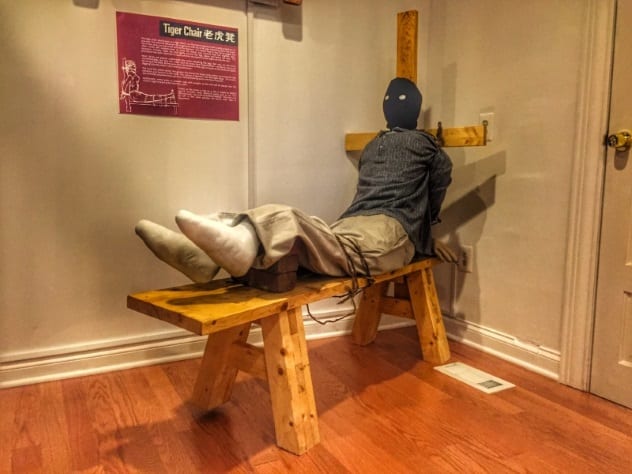
Laogai can be roughly translated as “reform through labor.” These camps were modeled after the Soviet gulags under Joseph Stalin and first opened their doors following Mao’s ascension to absolute power in 1949. Although they have been renamed, hundreds of laogai camps are still in operation today throughout China.
One survivor of the laogai system, Harry Wu, has said that during the height of Mao’s power, some 40 million Chinese people were interned at these labor camps. Wu, who now lives in the United States and runs the Laogai Museum after spending 19 years in a laogai, claims that these reeducation camps forced inmates to work for hours on end under dangerous conditions. Food and water were rarely given to the inmates, thus forcing them to steal from each other. Inmates at these camps were also used for the harvesting of organs, a process that is still going on inside China right now.[9]
According to Wu, one of the more gruesome torture methods used by these labor camps is the tiger chair, which is a bench where prisoners have their hands tied behind their backs, their mouths gagged, and their legs bound tightly with rope. Bricks are then placed underneath the legs, thus elevating them. Prisoners tied to the tiger bench are shouted at by guards and are forced to hold these uncomfortable positions for hours and sometimes days.
Such inhumanity should not be shocking. After all, the architect of these camps, Mao Zedong, oversaw the Great Chinese Famine (1958–1961), which may have killed 30 million people out of a population of 650 million. The famine was caused by the Great Leap Forward, which was an attempt rapidly modernize China into an industrial society. This mass starvation was followed by the Cultural Revolution, which saw radicalized college students (“Red Guards”) publicly denouncing their teachers and family members as “counterrevolutionaries.” Through show trials and struggle sessions, in which the accused were forced to confess to a litany of anti-communist crimes, counterrevolutionaries were sentenced to labor camps or were executed. The total number of deaths during the period (1966–1976) is not known, but most estimates say that somewhere between 1.5 and 7.7 million people died.
2 Stalin’s Gulags
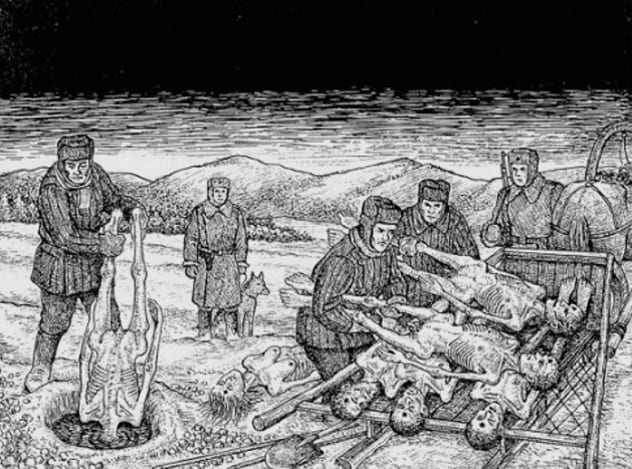
No communist leader is more infamous than Joseph Stalin. During his lifetime, Stalin was credited with turning the mostly agrarian Russia into an industrial powerhouse. However, Stalin did so by killing millions of his own people through overwork, starvation, and execution. During the Great Purge, when all those suspected of disloyalty to Stalin and his forced labor system were imprisoned and executed, 20 million people were killed by state authorities. Collectivization, whereby peasants were forced to produce food in order to meet unrealistic government quotas, killed millions more. For instance, in Kazakhstan between 1930 and 1933, collectivization led to a famine that killed 1.5 million people. The Holodomor, a forced famine designed to punish independent peasants in Ukraine, claimed about three million lives between 1932 and 1933, with an estimated 28,000 Ukrainians dying of starvation daily.
Stalin’s government expanded Lenin’s gulag system in order to house those deemed antagonistic to collectivization. Gangsters and serious criminals were also housed in these camps, and guards encouraged them to brutalize the political prisoners. Those inmates without connections (i.e. in good with the guards) typically worked 14-hour days. Jobs included cutting down and hauling lumber, digging ditches for hydraulic dams, and mining for ore and coal. Prisoners were kept on starvation diets, with many dying from malnourishment, dehydration, exhaustion, and lung diseases stemming from the inhalation of ore and coal dust.
Survivors of Stalin’s gulags, including writers Varlam Shalamov and Aleksandr Solzhenitsyn, wrote books about the inhumane and barbaric conditions of the gulags, where murder and robbery were commonplace among starving inmates. A more graphic depiction of gulag life can be found among the sketches of former camp guard Danzig Baldaev. For decades, Daldaev worked as a gulag guard, and during that time, he sketched pictures of what he saw. These stark images include depictions of forced feeding, gangsters urinating on beaten and bloody inmates, decapitations, the insertion of soldering irons into vaginas and anuses, and the institution of female and child sex slavery within the camps.[10]
1 The Pitesti Experiment
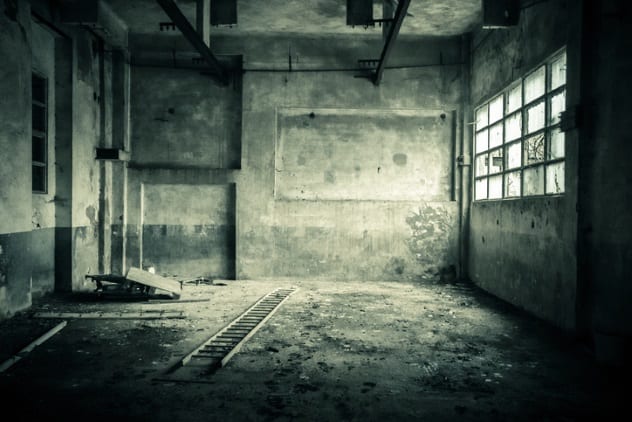
What happened in Romania between 1949 and 1951 was so horrific that it turned the stomachs of hardened Soviet officials. Known collectively as the Pitesti experiment, these reeducation experiments were conducted inside the Pitesti Prison. The ultimate monsters in charge of these experiments were Ana Pauker and Eugen Turcanu. On the surface, these two could not have been more different. Pauker came from an Orthodox Jewish family and was a lifelong leftist, with former membership in both the Social Democratic Party of Romania and the Socialist Party of Romania. Turcanu was an ex-con and a former member of the anti-Semitic Iron Guard.
Together, Pauker and Turcanu used Pitesti Prison as a laboratory to build new communists out of the ashes of old Romania. Their subjects included former members of Ion Antonescu’s regime, members of the Iron Guard, landowners, diplomats, Orthodox and Catholic priests, intellectuals, Jews accused of being “Zionist,” and other members of the bourgeois. These inmates were dubbed “enemies of the people,” and all manner of torture was meted out to them by Turcanu, Pauker, and their minions.
Examples of torture included: forcing prisoners who did not renounce their Christian faith to take a “communion” consisting of fecal matter, forcing prisoners who did not confess to anti-communist activities to put their hands in chamber pots full of urine, forcing inmates to spit into the mouths of suspected spies, and forcing prisoners to mock Christ’s nativity on Christmas day. Survivors claim that Turancu was especially creative with priests and devout Christians. Every morning, these inmates would be “baptized” with urine and fecal matter. Their heads would be held inside the putrid buckets almost to the point of drowning.[11]
The point of the experiments was to force people to confess to the fact that they deserved all of this punishment because of their past anti-communist activities. The experiments also sought to destroy any individualism within the inmates. In order to accomplish both, physical torture was coupled with long periods of solitary confinement. Torture, which was almost always carried out by other inmates (most of whom were students sent to the prison because they had belonged to non-communist political parties), included forcing prisoners to eat with their knees on the floor and their hands tied behind their backs. Often, the food they were forced to eat was each other’s excrement. On Easter morning in 1950, prisoners were forced to kiss a phallus-shaped piece of insect-repellent paper, while on most other days, they were encouraged to commit suicide. This latter activity was usually stopped by guards, who simply wanted to prolong an inmate’s torture. One prisoner, Turcanu’s former friend Bogdanovici, died after other inmates jumped up and down on his stomach and chest for days, thus crushing his internal organs.
The experiments came to an end when Gheorghe Gheorghiu-Dej, the general secretary of the Romanian Communist Party, successfully lobbied Stalin to purge the Romanian Communist Party of Pauker and her supporters. Specifically, Pauker was accused of being a “Zionist” and of having “nationalist” attitudes toward Jewish immigration to Israel.
As for Turcanu, he and his handpicked guards stood trial for their crimes in 1954. On December 17, 1954, Turcanu was executed by firing squad. After Turcanu’s death, the Romanian Communist Party tried to say Turcanu and Pauker were responsible for all the crimes at Pitesti, but most scholars today believe that the party encouraged the experiments.
Read more horrific tales from prison camps on 10 Chilling Accounts Of The Siberian Gulags and 10 Horrifying Accounts Of North Korea’s Prison Camps.
